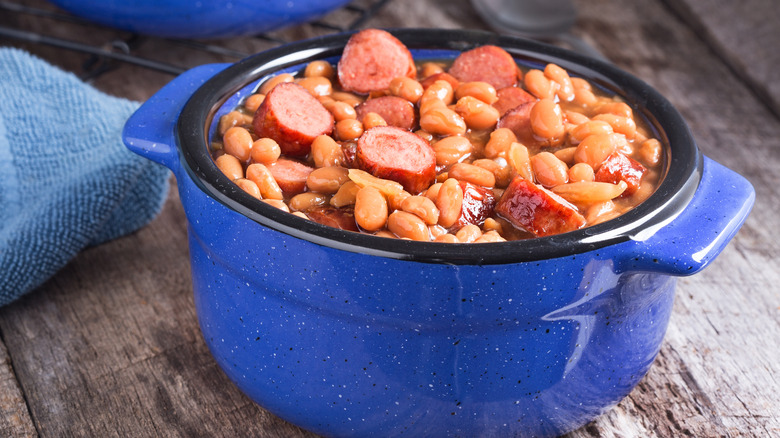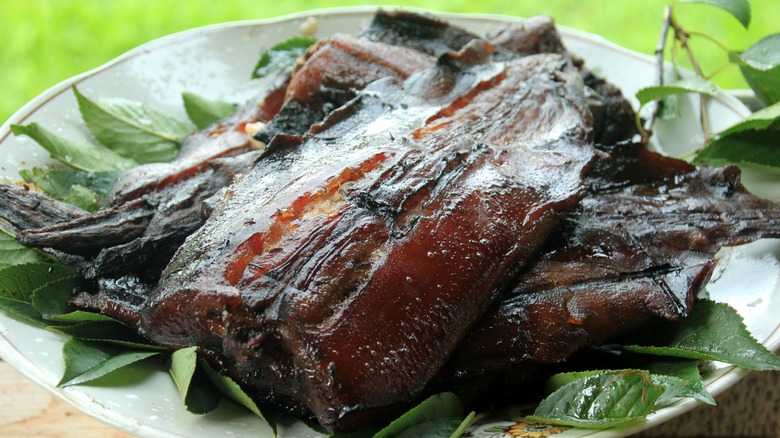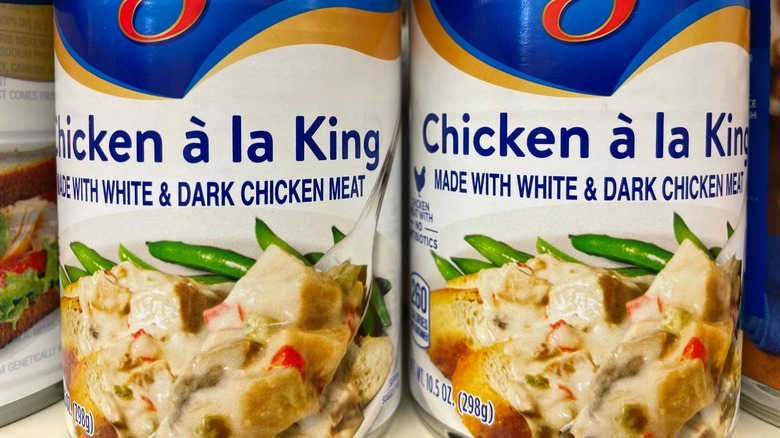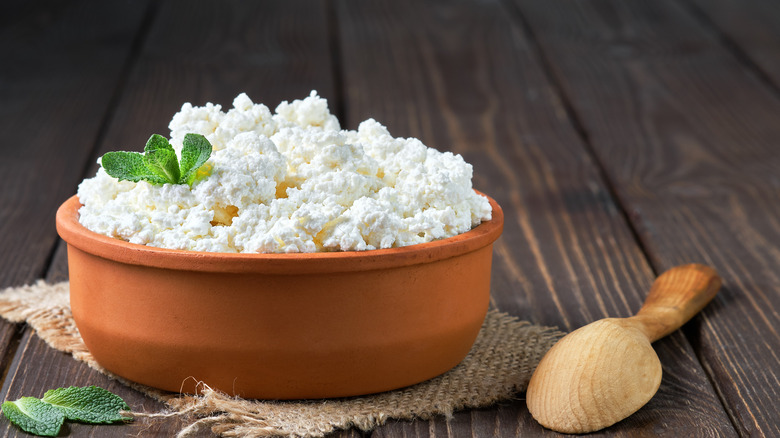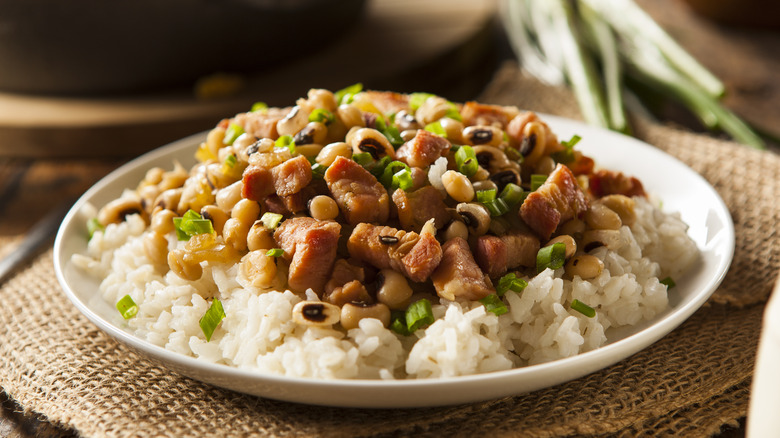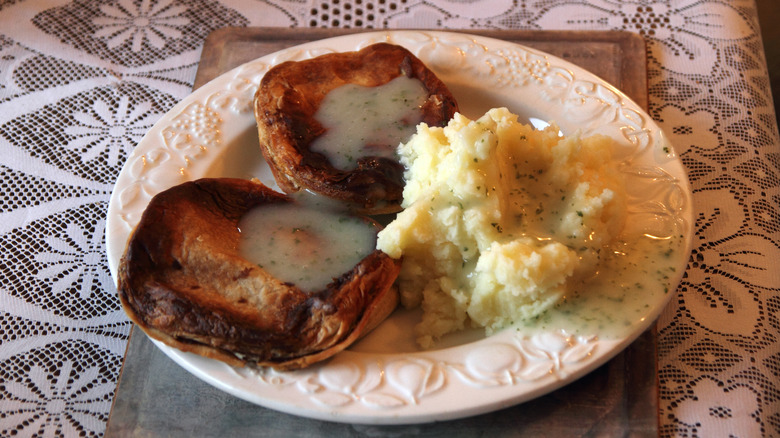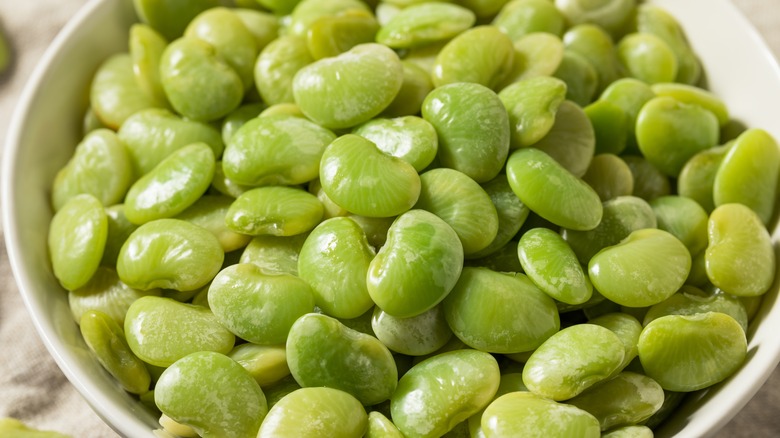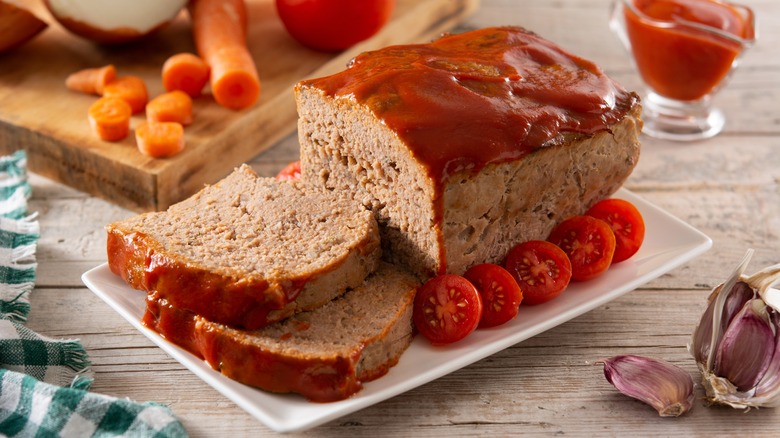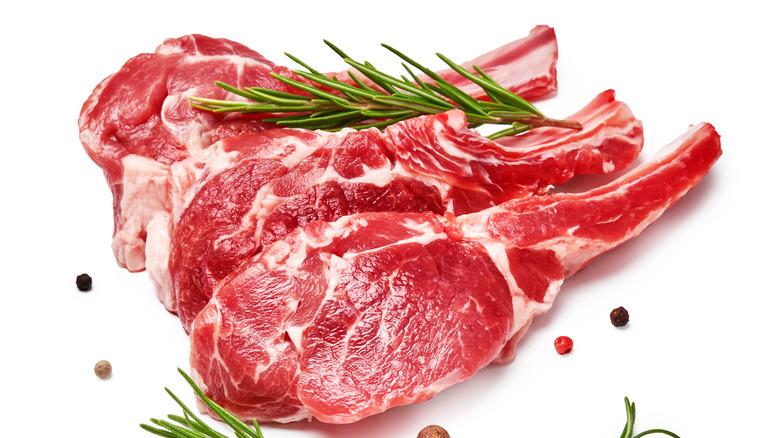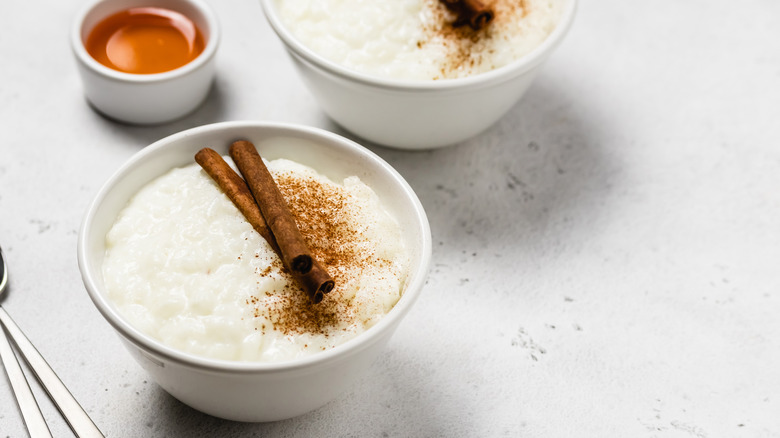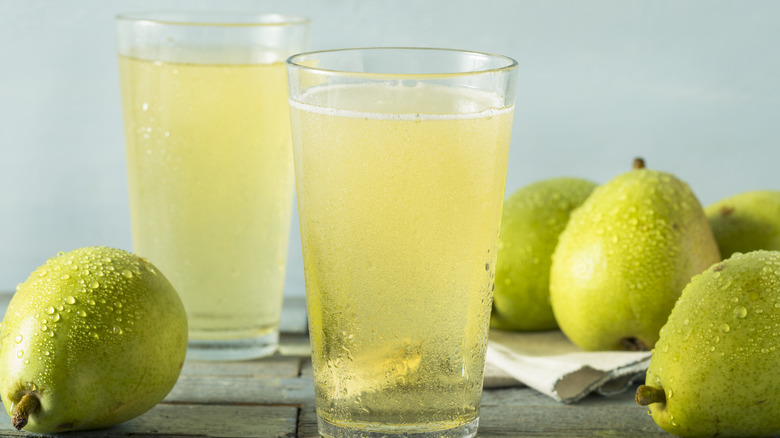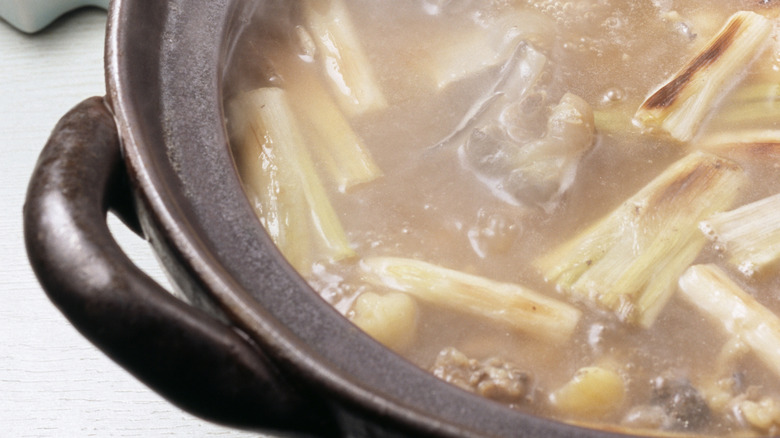19 American Comfort Foods That Time Forgot
When asked what your favorite comfort food is, your answer won't be the same as the next person's. They will probably have something in common, though: A lot of calories. And while the concept of comfort food has been around for a long time, the term itself is not that old. According to JSTOR, Liza Minnelli is credited with coining the term in 1970. In her words, "Comfort food is anything you just yum, yum, yum." Indeed. But the foods that make us go "yum, yum, yum" change over time, and some of them become lost to time.
Comfort foods exist worldwide, and in the United States alone, they vary quite a bit by region. This list is by no means exhaustive, and many of the items are still eaten. However, for some, the way they are enjoyed has transformed, whether due to changes in accessibility or simply shifting food trends. Others truly are dishes of a bygone era.
1. Beans and franks
According to the University of Wyoming, July 13th is National Beans 'n' Franks Day, the perfect date for this hearty classic American meal. The dish is also known as "beanie weenies," a proprietary name owned by the Van Camp brand, which sells a canned version of this comfort food.
While the exact origin of beans and franks is unknown, baked beans themselves date back to the U.S. Civil War. National Day Calendar says that baked beans were one of the first canned foods Americans could buy and were first sold in the 1890s.
Though you buy canned franks and beans, it is a straightforward recipe to make at home. You can buy canned baked beans to accompany your hot dogs or whip up your own by mixing navy beans with a delicious sauce of "brown sugar, onion, mustard, barbecue sauce, and spices." The health risks associated with hot dogs and other processed meats (per Physician's Committee for Responsible Medicine) may be part of this dish's decline in popularity. If you're hankering for some beans and franks but wary of those risks, you could swap in some carrot-based "not" dogs, instead.
2. Beaver tail
No, we're not talking about the Canadian donut, BeaverTails (those, according to the CBC, are still quite popular). The beaver tails in question belong to the semi-aquatic rodents that were once rampant across North America, says Scientific American — think between 60 and 400 million. Before the arrival of European colonists in the 17th century, Native American populations hunted them sustainably, but colonists used beavers for fur and their excretions for perfume. All that hunting meant that beaver tail was a practical source of protein and fat for hunters as well.
Adding to the European appetite for beaver meat was the fact that the Catholic church declared the mammal a fish due to their semi-aquatic nature, meaning they were permissible to eat on Fridays and during Lent.
According to Smithsonian Magazine, beaver recipes could be found in cookbooks up until the 1940s. That's not to say that no one eats beaver anymore. In fact, Canada's Northwest Territories Health and Human Services still recommend it as a safe and healthy food. However, North American hunting regulations mean that beaver populations are now increasing and stabilizing.
3. Breakfast
We've all heard the adage, "breakfast is the most important meal of the day." But what's the reason people believe this? As with so many things, the answer is good marketing. According to The Daily Telegraph, the phrase dates back to 1917 when a dietitian named Lenna Cooper used it in a magazine published by John Harvey Kellogg (yes, that Kellogg).
That said, the suggestion that breakfast should be a daily must isn't without merit — but it isn't a hard rule, either. Nowadays, more than half of Americans skip breakfast at least once a week, and 12% never eat it. A registered dietitian, Beth Czerwony, told the Cleveland Clinic, "Much of the advice relating to the importance of breakfast is based on observational studies ... These studies aren't randomized clinical trials that prove their importance." She goes on to say that while eating a protein-rich meal within two hours of waking up is best for most people, everyone should listen to their body's "hunger cues."
That said, a hearty breakfast can be the perfect weekend comfort meal, so let's bring it back into fashion. Next time you want to start your Saturday or Sunday off right, enjoy a sit-down breakfast at your local diner.
4. Chicken à la king
Chicken à la king was once a ubiquitous classic, but now it's virtually disappeared. It's now so rare we wouldn't blame you if you're scratching your head, asking, "What is chicken à la king?" In essence, it is a dish of chicken, mushroom, and peppers in bechamel served over toast (per Politico). Despite the "à la" in its name, this dish doesn't have French origins. According to Bklyner, chicken à la king was likely created in early 20th century New York at the Brighton Beach Hotel in honor of the hotel's owner, E. Clara King II.
Chicken à la king was featured on over 300 menus in the first half of the 20th century, but attempting to find it today often results in a scavenger hunt. What's more, when you do find it, it's likely not as a fancy dish served at formal events but as a menu item at the odd diner or in your grocery store's frozen and canned food aisles.
5. Cottage cheese
Cottage cheese is a fresh cheese that's gotten a bad rap as a diet food or a less delicious way to eat toppings you'd normally eat with yogurt. But as The Food Historian points out, cottage cheese and similar cheeses have long been eaten in Eastern European cuisines and are still very popular.
Cottage cheese rose to fame in the United States during World War I when it was marketed as an affordable meat replacement to deal with a dairy surplus and meat shortage. In 1918, the USDA even published a pamphlet entitled "Cottage Cheese Dishes." This "propaganda" was repeated in World War II, after which marketing switched to pushing the cheese as a diet food.
According to NPR, U.S. cottage cheese consumption peaked in the 1970s when the average person gobbled up about 5 pounds a year. Now that number has halved, while the amount of yogurt people eat has increased by more than 600%.
6. Hoppin' John
Chances are that if you live in the U.S. American South or have visited the home of someone from the region on New Year's Eve, you've had hoppin' John. This yummy stew featuring black-eyed peas and green has evolved through the years. Once made with rice mixed in, the rice is now often an accompaniment. Likewise, original recipes always featured pork, but nowadays, many cooks swap in other meats or use no meat. Per History, hoppin' John first showed up in cookbooks in the 1840s, but enslaved peoples in the region had been making it for far longer than that.
Rice and black-eyed peas were food crops from West Africa that were brought over with the enslaved peoples. As with a lot of what is traditionally known as Southern cuisine — a food culture that enslaved people created by mixing their traditions with what was available to them in the United States — hoppin' John eventually morphed from daily sustenance to a holiday food on many Southern tables.
The origins of the dish's name are contested, but the most inoffensive and agreed-upon is that the name is an alteration of the French term for pigeon peas, "pois pigeon."
7. Eel pie
Most people in the United States today associate eel with Japanese food. However, back in the 1600 and 1700s, this fish was a hot commodity, says Smithsonian Magazine. To compare how much the American appetite has changed, people back then used lobster as bait when hunting for eel in rivers and at Cape Cod back.
Early Americans prepared their eel in several ways. Sometimes the eel was jellied, but more often it was served in the form of savory pies. The latter form is a tradition that began in England. In fact, eel pies are still prevalent in England and served at "pie and mash shops." So, if you are interested in trying this dish, you know where to look.
However, the U.S. American appetite for eel dwindled along with the local population of the fish. The eel population did stabilize as the popularity of the dish declined; unfortunately, as the demand for sushi increased, the eel population once more declined. It is now a threatened species.
8. Fluffernutter sandwich
Marshmallow crème has been around for a while, but the combination of the fluffy white stuff with peanut butter and bread has its origins in the time of Paul Revere. Well, in the sense that his great-great-great-granddaughter, Emma Curtis, created and published a recipe for a peanut butter and marshmallow crème sandwich during World War I (per the New England Historical Society). Back then, she called it a "Liberty Sandwich." Curtis and her brother, Amory Curtis, popularized marshmallow crème when they began selling their version, Snowflake Marshmallow Crème, in the early 1900s.
Shortly after WWI, their company began selling marshmallow fluff. They included recipes for marshmallow fluff and peanut butter sandwiches on the label. The sandwich got its modern name in 1960, thanks to an advertising campaign. The fluffernutter may no longer be a national treat, but it's still a New England staple.
In case you're wondering: The difference between marshmallow crème and fluff is ... it depends. Marshmallow crème is an umbrella term under which the fluffy stuff certainly falls. Some crèmes do not include egg whites, while others do (but fluff certainly does). And fluff involves whipping the product.
9. Lima beans
Indigenous Americans have been eating lima beans for centuries. In fact, according to an article published in Arqueología Mochica: Nuevos Enfoques, the Moche people who lived between the 1st and 8th centuries in modern-day Peru used the beans as social currency (via the USDA). In North America, lima beans have long been part of what is known as the "three sisters," a trifecta of the most important elements of the indigenous people's diet. Growers planted, and continue to plant in the modern day, squash, corn, and beans (often lima) together for symbiotic benefits. In the 1600s, Native Americans introduced European colonialists to the lima-bean-based dish succotash (according to the New York Times via USDA). The word succotash comes from the Narragansett word msickquatash, meaning a corn stew with other ingredients added.
However, it wasn't until the late 1800s, when the Burpee Seed company was taking off and began selling its "Fordhooked" bush cultivar, that the legume became a nationwide garden staple. The USDA continued to publish literature about growing and developing this crop into the 1970s. In one such publication, the agency laments that lima beans aren't fully appreciated by the public, as their value as a dried bean isn't well known. Maybe that's why many modern recipes for succotash replace lima beans with other legumes, such as edamame.
10. Meatloaf
Like many comfort foods, meatloaf is essentially a struggle meal, born out of needing to use every scrap of food available. Although meatloaf can be traced back to Roman times, today's meatloaf is closely related to a dish called scrapple, which you can still find in diners as a breakfast. German colonists created scrapple by cooking cornmeal and scraps of pork. The first modern meatloaf recipe was published in the 1870s, and 20 years later, as agricultural practices industrialized, more meat scraps became available and the dish became more popular. However, meatloaf reached peak popularity in the U.S. during the Great Depression and World War II, when it really saved people on the cost of meat.
While people have always put their own spin on the dish, since the 1950s, cooks have taken a more playful approach, such as adding fruit or creating plant-based versions. Perhaps this is to stave off cries, from Rocky Horror Picture Show fans and bored eaters alike, of "meatloaf again?"
11. Mincemeat
Mincemeat may seem a misnomer, considering most canned mincemeat is actually vegan. But What's Cooking America says that the dish originated in England as a way to preserve meat, not as a fruit-forward dessert. Mincemeat pies have been part of the English Christmas table since the Crusades, but "back then," they were main-dish, savory pies. The savory pie has gone through a few iterations, but the basic idea is a pastry filled with minced meat, suet, fruit, alcohol, and spices.
Cooking meat in spices is common in MENA (where the Crusaders were). As is often a side effect of war or colonialism, 11th-century Crusaders brought the technique back to England. They used cinnamon, cloves, and nutmeg in their Christmas pies to represent the three gifts of the Magi. Recipes in 16th-century English cookbooks feature the dish, and the dish was even banned (along with Christmas) more than once by Puritans in England and the U.S.
The meatless, dessert version of this comforting Christmas treat began during the turn of the 20th century as a result of rapid industrialization and wartime meat rations.
12. Mutton
Mutton — the meat of adult sheep — is a popular dish outside the United States. It was once eaten regularly here too. As the manager of Keens Steakhouse, Bonnie Jenkins, told NPR, "In the early 1900s, there were 237 menus with mutton." Further, on the Titanic, first-class passengers got mutton while second-class was served lamb. So what happened? Well, the decline of mutton in the U.S. is multifaceted. Today, the factors preventing this meat from making a comeback are primarily economic. Raising sheep into adulthood is more expensive than slaughtering them young. Also, mutton has long been a byproduct of the wool industry, which has also declined in the U.S.
Other factors also played into the U.S. abandoning mutton as a popular comfort food. In the late 19th and early 20th century, there were literal turf wars between cattle and sheep farmers in the American West, with government support usually going to cattle farmers. Then, in World War II, canned mutton was a staple on the menu, so much so that G.I.s who returned home wanted nothing to do with the stuff. Compound that with the fact that mutton takes much longer to cook than beef and you've got once-celebrated meat now dethroned.
13. Rice pudding
While rice pudding is ancient and comes in many versions worldwide, such as arroz con leche and rice kheer (via Greengos Cantina), the version many Americans are familiar with, simply called "rice pudding," isn't as popular in the United States as it once was. That version likely originated in England and contains a high ratio of custard to rice. Recipes for this version date back to at least the year 1400, according to British Food: A History. However, when we look at pudding trends on social media over at Taste Wise, conversations about pudding are decreased by 12.5% from 2021 to 2022, and most people searching for pudding are looking for vegan pudding. While interest does spike during the Christmas season, it seems that this sweet treat has lost its popular comfort food status.
There may be hope for this humble and tasty dessert — across the pond. The Guardian reports that U.K. sales of the pudding have been soaring "while recipe searches are up 233%." If you'd like to jump on the nostalgia train, try this old-fashioned rice pudding recipe. For a vegan spin, try this horchata rice pudding recipe.
14. Robin pie
"Sing a song of sixpence, a pocketful of rye, four and 20 blackbirds baked in a pie." Thanks to that nursery rhyme, many of us may have heard of blackbird pie. And while today it might be uncommon to find any bird other than chicken or turkey finding its way into a pie, that wasn't always the case. Per NPR, robin pie was likely a 19th-century treat in U.S. American kitchens. The pie included a double-crust, beef, bacon, spices, and a dozen flour-coated robins. The flour was used to create a sauce in the pie.
The birds were likely abundant during migration from the North to the South and probably tasted good. But we do not recommend you try replicating this dish — though they are a widespread bird, the 1918 Migratory Bird Treaty Act protects American robins and their eggs from hunting. It also protects blackbirds, so don't go getting any ideas. However, while robin pie might be an outdated comfort food, you can get the same coziness, tender meat, and soupy goodness from a chicken pot pie.
15. Pear cider
Hard apple cider is a well-known treat, even today, but according to Smithsonian Magazine, early U.S. colonists also readily enjoyed perry (pear cider). Both perry and apple ciders were the drinks of choice before German immigrants introduced lager in the 1800s. Cider got so popular because pear and apple orchards bore an abundance of fruit that the colonists found easier to brew than beer. Plus, the fall temperatures in which these fruits are harvested were favorable for making and keeping cider.
According to NPR, today, perry is purely fermented pear juice, and the latter is a pear and apple mixture. There are special, smaller pears, called perry pears, used to make perry. Yeast cannot metabolize one of the sugars found in pears, so perry is sweeter than some apple ciders. With the resurgence of popularity in craft beverages and home brewing, it's possible that perry could make a comeback. And we think it should!
16. TV dinners
Swanson sold the first TV dinners in 1954 because they needed a way to sell off excess Thanksgiving turkey. Their TV dinners were an instant success. So, what's the real reason so many Americans have stopped buying TV dinners? Well, they haven't stopped, but the numbers are decreasing. Starting in 2008, the number of frozen meals sold didn't increase for the first time in about six decades.
That decline stayed steady until the pandemic. In 2022, frozen food sales had increased by 26% compared to 2020 (per Quartz). Take these numbers with a grain of salt, as they don't consider inflation or specifically include TV dinners (instead, frozen food as a whole). However, that latter point is part of the renaissance: Frozen food has gotten a makeover. The classic TV dinner has gotten an upgrade, as more brands work to cater to millennials and Gen Zers with healthier or seemingly healthier options, meaning the traditional TV dinner as we once knew it may soon be a comfort food that time forgot.
17. Tuna noodle casserole
The idea that seafood and cheese are a no-no combination is prevalent, which may be one of the reasons that tuna noodle casserole is such a divisive dish. Canned tuna with veggies, noodles, milk, and cheddar will conjure up either warm feelings of nostalgia or vague feelings of disgust. Having said that, that is probably not why this dish has lost its status as a classic comfort meal. It likely comes down to the plate's main ingredient. The Washington Post states that canned tuna is not as popular as it used to be. In the 1990s, U.S. Americans ate about 4 pounds of tuna per capita yearly. By 2008, that number halved, remaining steady into 2018 (per Statista).
Tuna noodle casserole itself is no spring chicken (of the sea). The first published recipe of the dish appeared in Sunset Magazine in 1930 (via Taste); however, the dish really took off in 1950s Middle America.
18. Green sea turtle and terrapin stew
According to New York Almanack, turtle meat has long been a Caribbean staple. As such, enslaved and indentured people from the region ate them, and their British enslavers soon followed, bringing the culinary staple to the United Kingdom. American colonists continued the turtle soup tradition in the states. While the stew was the most common preparation, turtle steak was also available. In the 1700s, people mostly ate green sea turtles, but by the early 19th century, few were left, so people turned to terrapins, or mud turtles, which were already a staple of the Native American diet.
Cooks often added alcohol to flavor the stew. By the time prohibition rolled around, terrapin numbers had dwindled to the point that the dish was already mainly for the rich. These days, snapping turtle soup is more or less the only turtle readily available as meat in the United States (according to Historical Cooking Project). However, if you're interested in trying this long-lost comfort food sans turtle, a Maryland crab soup is said to have a similar flavor profile.
19. Fluid cow's milk
Cookies and milk are a classic combination, and although it's likely an urban legend that a glass of warm milk will put you to sleep (according to The New York Times via WebMD), milk has long been associated with comfort and childhood. But fluid-milk consumption, which also includes "malted milk, eggnog, and hot chocolate, among other milk-based beverages," has been on the decline for seven decades. The USDA says the reasons are multi-faceted. While plant-based milks are part of this decrease, they aren't the only reason, considering the increase in plant-milk sales is less than the decline in fluid cow's milk.
Beginning in the 1960s, people born in each successive decade drink less liquid milk — of any kind — than the previous. In the 1980s and 90s, sodas and juice were milk's top competitors, but there's no single competitor these days. Also interesting is that most children's fluid milk consumption is at school, where milk is subsidized by the U.S. government, which could point to children drinking the beverage only by default. However, these numbers only pertain to fluid milk, as the U.S. is eating more cheese and yogurt than 50 years ago.
Fortunately, milk is the easiest comfort food to reproduce on this list. If you'd like to bring the tradition back to the modern day, try using a bottle of chocolate syrup and a milk frother to whip up a glass of creamy chocolate milk. It's almost like being a kid again!

